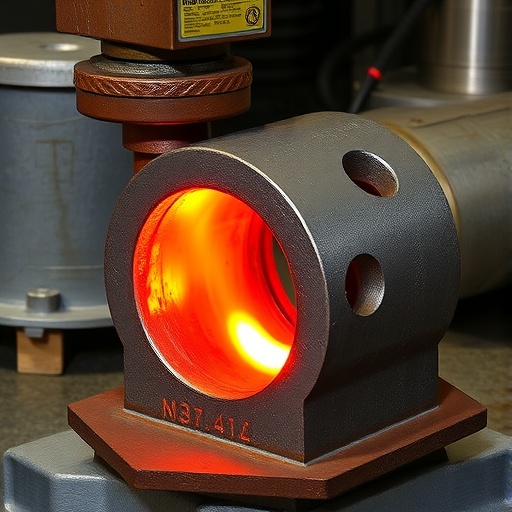In a groundbreaking new study published in Cell Death Discovery, researchers have unveiled unprecedented insights into the dynamic activity of NF-kappaB (NF-κB) during the steady-state maturation of neutrophils, a vital subset of immune cells. This investigation not only charts the elusive pathways of NF-κB signaling but also redefines our understanding of immune regulation during neutrophil development, which could have significant ramifications for therapeutic strategies against inflammation and immune disorders.
The intricacies of neutrophil biology have long fascinated immunologists, given these cells’ central role in innate immunity and their rapid deployment to sites of infection and injury. Neutrophils mature through distinct stages within the bone marrow before entering circulation, a process tightly governed at the molecular level to balance effective defense mechanisms while avoiding excessive inflammatory damage. NF-κB, a transcription factor family known for mediating immune responses, has been suspected to play a crucial role within this context — yet, direct measurements of its activity over the entire span of neutrophil development have been scarce until now.
Employing innovative single-cell approaches alongside a robust NF-κB reporter system, the research team led by Jeffries and colleagues tracked functional NF-κB signaling across the continuum of neutrophil maturation. By analyzing bone marrow samples from steady-state conditions (i.e., in the absence of external immune challenge), they were able to map the temporal dynamics of NF-κB activation with remarkable precision. These data revealed distinct phases where NF-κB activity is differentially modulated, challenging previous assumptions about the uniformity of signaling in neutrophil progenitors versus mature cells.
One of the most striking findings was the identification of a biphasic NF-κB activity pattern during neutrophil maturation. Early immature neutrophil precursors exhibited a significant suppression of NF-κB signaling, a state that likely serves to prevent premature activation and inflammatory gene expression that could disrupt developmental programs. As cells advanced toward terminal differentiation, this suppression was lifted, culminating in heightened NF-κB activity just prior to neutrophil egress into the bloodstream. Such a regulated switch suggests a finely tuned mechanism by which the immune system prepares neutrophils for their impending antimicrobial functions.
Delving deeper, the study also uncovered that this NF-κB modulation was tightly linked with changes in chromatin accessibility and transcriptional profiles. Using integrative multi-omic analyses, the researchers correlated NF-κB activity bursts with the upregulation of key neutrophil effector genes, including those involved in reactive oxygen species production and cytokine secretion. This connection implicates NF-κB not only as a passive marker but as an active driver of the functional maturation of neutrophils.
Importantly, the steady-state focus of this research provides a baseline framework to understand how neutrophil function might be perturbed in pathological conditions. Chronic inflammatory diseases, sepsis, and autoimmune disorders often manifest with dysregulated neutrophil responses, yet it has been unclear how alteration in NF-κB signaling patterns within developmental stages contributes to disease phenotypes. The findings from Jeffries et al. open avenues for targeted therapeutic interventions that aim to recalibrate NF-κB activity specifically during neutrophil maturation.
The utilization of advanced imaging and reporter constructs was pivotal to this work. The team engineered a sophisticated fluorescent NF-κB reporter mouse model enabling real-time visualization and quantification of transcription factor activity at the single-cell level. This technology allowed for unprecedented spatiotemporal resolution, capturing the subtle yet critical shifts in signaling that occur during steady, non-pathological states of hematopoiesis.
Furthermore, the employment of flow cytometry coupled with RNA sequencing enhanced the resolution of their investigative framework. This combined methodology facilitated the dissection of NF-κB signaling heterogeneity across developmental stages and cell subpopulations—a feat unattainable through bulk assays. The discovery of discrete NF-κB-activity-defined clusters suggests that neutrophil maturation encompasses functionally diverse subsets, each potentially adapted for specific immunological roles.
Beyond the basic science implications, this research invites a new perspective on drug development. Current anti-inflammatory therapies often target NF-κB with broad-spectrum inhibitors, risking immunosuppression or off-target effects. Understanding the nuanced role of NF-κB in neutrophil maturation highlights the potential for designing stage-specific modulators that preserve requisite immune functions while mitigating pathological inflammation.
Moreover, the study’s relevance extends to cancer biology, where neutrophils can serve dual roles in promoting or suppressing tumorigenesis. The NF-κB axis might constitute a critical pivot in determining neutrophil phenotypes within the tumor microenvironment. Future work inspired by this foundational research could decode how NF-κB-driven maturation pathways are hijacked or manipulated by cancer cells, potentially unveiling new immunotherapy targets.
Despite its breakthroughs, the study acknowledges some limitations, notably the focus on steady-state conditions. While this approach is essential to establish baseline knowledge, further investigations are required to determine how infectious or inflammatory stimuli reshape NF-κB dynamics in neutrophil development. Such research would be crucial for translating these findings into contexts of disease and therapeutic intervention.
Interestingly, the data also hint at potential feedback loops wherein mature neutrophils, upon activation, may influence NF-κB signaling in progenitor cells within the bone marrow niche. This cross-talk mechanism, if validated, would underscore a high degree of systemic immune integration where mature immune cells help calibrate the output and nature of new cells, ensuring homeostasis and fine-tuning immune readiness.
The implications for hematopoietic stem cell (HSC) biology are also profound. Given that neutrophils derive from common myeloid progenitors, the regulation of NF-κB at precursor stages might intersect with stem cell fate decisions. Explicating whether NF-κB signaling influences lineage commitment beyond neutrophils may provoke a reassessment of NF-κB’s broader role in hematopoiesis.
Ultimately, this pioneering work crystallizes the concept that transcription factor activity, such as that of NF-κB, is not merely a binary on/off switch but encompasses a complex repertoire of temporal and intensity modulations vital for immune cell function. The ability to track and quantify these dynamics with high granularity is a hallmark of modern immunology and serves as a template for exploring other critical factors in immune regulation.
As immunological research increasingly pivots toward systems-level understanding, this study exemplifies how integrating cutting-edge molecular technologies with classical immunological questions can yield transformative insights. The discovery of precise NF-κB activity patterns during neutrophil maturation is anticipated to resonate deeply, prompting reexamination of immune cell development and fueling innovative approaches to immune modulation.
In the coming years, follow-up studies will likely expand on these foundations, exploring NF-κB activity under diverse biological contexts, such as infection, autoimmunity, and aging. Such research holds promise to unveil the universal principles governing transcription factor dynamics in immune homeostasis and dysfunction alike.
This landmark article authored by Jeffries, Floyd, Mei, and colleagues represents a significant leap forward, offering a detailed molecular chronicle of NF-κB’s role in shaping the frontline defenders of innate immunity. In doing so, it not only enriches the scientific narrative but also lights the path toward novel diagnostic and therapeutic paradigms in immunology and beyond.
Subject of Research: The study focuses on investigating NF-κB transcription factor activity throughout the process of neutrophil maturation under steady-state (non-inflammatory) conditions.
Article Title: Tracking NF-kB activity across steady-state neutrophil maturation.
Article References:
Jeffries, N.E., Floyd, D.J., Mei, S. et al. Tracking NF-kB activity across steady-state neutrophil maturation. Cell Death Discov. 11, 437 (2025). https://doi.org/10.1038/s41420-025-02737-w
DOI: https://doi.org/10.1038/s41420-025-02737-w
Image Credits: AI Generated
Tags: bone marrow neutrophil maturationdynamic activity of NF-kB during developmentimmune regulation mechanismsinflammation and immune disordersinnate immunity and infection responseneutrophil biology and developmentneutrophil maturation and immune responseNF-kappaB signaling in neutrophilsNF-κB reporter system in researchsingle-cell analysis of neutrophilstherapeutic implications of NF-kB researchtranscription factors in immune cells




